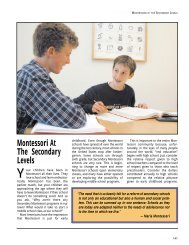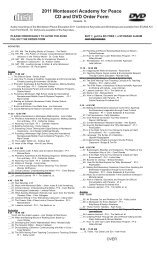Tim Seldin & Paul Epstein Ph.D. An Education for Life
Tim Seldin & Paul Epstein Ph.D. An Education for Life
Tim Seldin & Paul Epstein Ph.D. An Education for Life
Create successful ePaper yourself
Turn your PDF publications into a flip-book with our unique Google optimized e-Paper software.
MONTESSORI PROGRAMS<br />
(Above) Young children enjoy constructing new shapes with a wide variety of blocks and connecting<br />
materials.<br />
Why don’t more schools offer<br />
infant-toddler programs? Basically<br />
there are four major reasons.<br />
The first is that there are very few<br />
certified Infant-Toddler Montessori<br />
teachers.<br />
Secondly, because only a handful<br />
of children are supporting the<br />
trained teaching staff and classroom,<br />
these programs are more expensive<br />
to run than the classes <strong>for</strong> three to<br />
six-year-olds, and few schools feel<br />
that they can ask parents to pay the<br />
true cost of operation. As a result,<br />
many schools lose money on this<br />
type of program. The compensation<br />
is that the children who come<br />
through these programs will be<br />
178<br />
among their very best students in the<br />
years to come because of their early<br />
start. In some cases, state regulations<br />
may prohibit schools from accepting<br />
children under age three. Similarly, in<br />
some states, operating a program at<br />
this age level may cause the school to<br />
be classified as a child-care center,<br />
rather than as an educational institution.<br />
<strong>An</strong>d finally, many Montessori administrators<br />
wrestle with the concern that<br />
if they accept children under age<br />
three, prospective parents will view<br />
the school as a day-care center, rather<br />
than as a school, which some administrators<br />
fear might cause their entire<br />
program to lose credibility.<br />
The Four Common Types of<br />
Infant-Toddler Programs<br />
Parent-Infant Programs<br />
These are primarily programs designed<br />
to educate the parent of very young<br />
children in child development and<br />
the Montessori strategies <strong>for</strong> helping<br />
parents to respond to the needs they<br />
observe in their infants. These programs<br />
give parents an opportunity to<br />
observe their children and, through discussion,<br />
learn how they can best<br />
respond to their babies’ needs. Normally,<br />
parent-infant programs will accept<br />
children under eighteen months of age.<br />
Parents come with their children to a<br />
short class normally lasting about ninety<br />
minutes, held once a week. Often,<br />
there will be a parent-teacher discussion<br />
held at another time during the<br />
week. Topics always include parent<br />
questions and concerns and a weekly<br />
topic, such as: sleep, nutrition, home<br />
environment, and infant and toddler<br />
development. The staffing is commonly<br />
one certified Montessori Infant-Toddler<br />
teacher with the parents working in the<br />
A Note on Staffing: A key issue with infant<br />
programs is the adult-to-child ratio. State<br />
regulations vary, and the required ratios and<br />
maximum group sizes will vary from one<br />
state to another. The standard that we recommend<br />
<strong>for</strong> this age is lower than most<br />
states require – striving <strong>for</strong> a one-to-three<br />
adult-to-infant ratio, or a small group of<br />
normally nine infants to one teacher and<br />
two adult assistants. This tends to make<br />
such programs more expensive, but due to<br />
the low adult-to-infant ratio and the special<br />
training needed, the quality is well worth<br />
the cost. It is especially important that staff<br />
turnover in these programs be very low, as<br />
even the youngest infant tends to bond<br />
deeply with the adult caregivers. Their consistency<br />
over time is very important to the<br />
program’s success.




